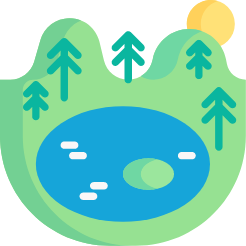IMPACT
EUROLakes will go beyond the current state of project development, by combining stakeholder feedback, iterative updates of NBS-focused demonstration activities, modelling exercises aimed at assessing human interactions, and nature finance capacity building, into an integrated adaptive management approach. This approach will be ready to be replicated and applied during and after the project for achieving a long-term solution to alleviating pressures on natural lake ecosystems.
EUROLakes pathway to impact is aligned with Mission Ocean and Waters objective to protect and restore marine and freshwater ecosystems and biodiversity.

development and piloting phase

deployment and upscaling phase
Expected Outcomes
EO1: Enhance the implementation of the European Green Deal and other EU strategies and policies concerning freshwater ecosystems by utilizing the 4 Returns Framework
The EUROLakes project follows the 4 Returns Framework for landscape restoration to revive Europe’s lakes, bringing them back to a healthy, thriving state while supporting the European Green Deal and key Sustainability Development Goals, such as SDG14, SDG6 and SDG13. With measures for improving water quality, reducing waste and implementing nature-based solutions, it contributes to climate resilience and major EU policies like the Water Framework Directive (WFD) and the Nature Restoration Law. The project will develop and disseminate policy recommendations to support the integrated implementation of EU freshwater ecosystem policies at national and EU levels, as well as inform international mechanisms like the Ramsar Convention.
EO2: Improved ecological and chemical status of European natural lakes
EUROLakes is tackling the challenges of three specific, ecologically pressured lakes: Lake Dümmer, Lake Vico and Lake Bistreț, each suffering from issues like agricultural pollution, nutrient overload, habitat degradation and threats to wildlife, such as reproduction of protected bird species, reed decline and impoverished fish fauna. Through tailored restoration plans, the project will implement nature-based solutions — such as reed and substrate restoration, aquatic vegetation planting and buffer zone creation — to fight these pressures and restore the lakes’ health. By improving their ecological and chemical status in accordance with WFD standards and replicating the solutions in similar areas, the project aims to create a scalable model for revitalizing Europe’s lakes.
EO3: Demonstrated integrated and replicable approaches to protection and restoration of natural lake ecosystems, their biodiversity and healthy functioning, integrating all aspects of good ecological and chemical status of lakes under the Water Framework Directive
The demonstration activities are at the core of EUROLakes approach, showcasing integrated and replicable protection and restoration (P&R) measures for natural lakes. The demonstrations will provide for an iterative refinement and adaptation of the proposed solutions with local stakeholders, directly addressing key pressures through nature-based solutions, reducing agricultural pollution, enhancing species conservation and strengthening management strategies to improve ecological and chemical status of the lakes. By continuously monitoring outcomes and updating measures based on site-specific feedback and impact assessment modeling, the project will develop an innovative, scalable approach to lake restoration that can be applied across Europe and beyond.
EO4: Demonstrated effective and replicable nature-based solutions for restoration and protection of European lakes
Nature-based solutions (NBS) are at the core of EUROLakes’ protection and restoration measures, addressing key ecological pressures through regionally and EU-replicable roadmaps. Pilot NBS—such as buffer areas and retention basins for Lake Vico, reed restoration and erosion control for Lake Dümmer, and floating vegetation protection and nesting platforms for Lake Bistreț—are co-designed with local stakeholders and integrated into regional plans to amplify their impact and enable replication across three countries with similar lake ecosystems.
EO5: Demonstrate improved solutions and systems for effective collaboration between, municipalities, regions and, if relevant, countries within a lake catchment area
EUROLakes places strong emphasis on establishing communities of practice to drive effective lake restoration through multi-stakeholder collaboration. Using the 4 Returns Framework and its 5 Elements process, the project integrates a Participatory Multi-Criteria Analysis (PMCA) and a Participatory Integrated Community-Based Approach (PICBA) to engage municipalities, local actors and diverse stakeholders in jointly evaluating, planning and implementing restoration measures. By fostering cooperation among municipalities and incorporating best practices like the Dümmer Forum, EUROLakes creates a model for long-term, regionally coordinated lake management that balances different and even competing interests.
EO6: Create opportunities for scaling up of solutions for P&R of European lakes through involvement of local and regional authorities
EUROLakes will demonstrate the replicability and scaling-up of its restoration solutions by selecting associated regions facing similar ecological pressures as Lakes Vico, Bistreț and Dümmer. These regions will receive support and funding to implement protection and restoration measures based on the 4 Returns Framework, with a strong focus on natural returns. Knowledge from the main demonstration sites — governance and stewardship, digital modeling and landscape finance — will be transferred to these replicators, whose implementation results and reports will further promote EUROLakes’ approach at a transnational and EU level through policy initiatives and project synergies.
Contributing to society, economy
and the environment
Scientific Impact
Demonstrated effectiveness of integrated restoration measures for improved ecological and chemical lake status, monitoring changes in quality elements under the Water Framework Directive
Political Impact
Enhanced implementation of EU policies, particularly in alignment with the 4 Returns
Framework;
Improved collaboration between municipalities and regional authorities
Societal Impact
The establishment of new local Communities of Practice (CoP) empowers communities to take an active role in their lake conservation
Economic Impact
Attracted additional funding for lake restoration projects from both public and private sources, ensuring continued investment in water and ecosystem quality
Environmental Impact
The integration of nature-based solutions (NBS) into lake ecosystems contributes to long- term reduction in human impact and a shift towards more sustainable land management practices

